Deep Analysis of the Homogenization Phenomenon of the Ancient Water Towns in Jiangnan: A Dual Perspective on Landscape Patterns and Tourism Destination Images
Abstract
:1. Introduction
2. Literature Review
2.1. Jiangnan Water Towns and Homogenization
2.2. Heritage Tourism Attractions
2.3. Landscape Pattern Analysis
2.4. Tourism Destination Image Analysis
3. Materials and Methods
3.1. Study Area
3.2. Materials
3.3. Research Methods
3.3.1. Research Framework
3.3.2. Description of the Spatial Form of Ancient Towns—Landscape Pattern Index
3.3.3. Homogenization Direction of Ancient Town Morphology—Clustering Algorithm (K-Means)
- 1.
- Let X be a given data sample containing n objects , where each object has m-dimensional attributes;
- 2.
- The sample is partitioned into k cluster centers, . The Euclidean distance from each object to each cluster center is calculated using the following mathematical expression:
- 3.
- The sample is assigned to which center is closest to a center, and k clusters are obtained ;
- 4.
- The mean value of each center sample is calculated, and the calculation formula is as follows:
3.3.4. Analysis of the Tourist Destination Image of Ancient Towns—A Textual Analysis
4. Results
4.1. Spatiotemporal Characteristics of Ancient Town Form
4.2. Homogenization Features of the Ancient Town Form
4.3. Homogenization Characteristics of the Tourist Destination Image of Ancient Towns
4.3.1. Word Frequency and High-Frequency Words
4.3.2. Sentiment Analysis and Satisfaction Evaluation
4.3.3. Semantic Network Analysis
5. Discussion
5.1. The Shape of Ancient Towns in Jiangnan Water Towns Is Gradually Homogenized
5.1.1. Homogenization: The Result of Multiple Factors
5.1.2. Spatial Form: Corresponding to Local Identity
5.1.3. Emphasize the Sustainability of the Ecological Landscape of Tourist Destinations
5.2. The Tourist Destination Image of Ancient Towns
5.2.1. Perception of Tourist Destination Image and Strategies
5.2.2. Sentiment Analysis Destination Image and Strategies
6. Conclusions
Supplementary Materials
Author Contributions
Funding
Institutional Review Board Statement
Informed Consent Statement
Data Availability Statement
Conflicts of Interest
References
- Alan Fyall, B.G.; Leask, A. (Eds.) New Directions for Tourist Attraction Management; Guo, Y., Translator; Dongbei University of Finance and Economics Press: Shenyang, China, 2005; p. 206. [Google Scholar]
- Ohe, Y. Investigating farmer’s identity and efficiency of tourism-oriented farm diversification. Tour. Econ. 2022, 28, 535–558. [Google Scholar] [CrossRef]
- Scherrer, P.; Alonso, A.; Sheridan, L. Expanding the destination image: Wine tourism in the Canary Islands. Int. J. Tour. Res. 2009, 11, 451–463. [Google Scholar] [CrossRef]
- Azmi, E.; Che Rose, R.A.; Awang, A.; Abas, A. Innovative and Competitive: A Systematic Literature Review on New Tourism Destinations and Products for Tourism Supply. Sustainability 2023, 15, 1187. [Google Scholar] [CrossRef]
- Zhu, J.; Wang, H.; Xu, B. Using fuzzy AHP-PROMETHEE for market risk assessment of new-build river cruises on the Yangtze river. Sustainability 2021, 13, 12932. [Google Scholar] [CrossRef]
- Sharma, S.; Joshi, P.K.; Fürst, C. Exploring multiscale influence of urban growth on landscape patterns of two emerging urban centers in the Western Himalaya. Land 2022, 11, 2281. [Google Scholar] [CrossRef]
- Porfyriou, H. Urban heritage conservation of China’s historic water towns and the role of Professor Ruan Yisan: Nanxun, Tongli, and Wuzhen. Heritage 2019, 2, 2417–2443. [Google Scholar] [CrossRef]
- Li, Y.; Zhang, J.; Chen, Y. Image of landscapes in ancient water towns—Case study on Zhouzhuang and Tongli of Jiangsu Province. Chin. Geogr. Sci. 2006, 16, 371–377. [Google Scholar] [CrossRef]
- Liu, S.; Shu, H. Sustainable cultural tourism and heritage conservation in China: Case studies of the ancient waterfront towns in the south of the Yangtze River. WIT Trans. Ecol. Environ. 2020, 241, 15–26. [Google Scholar]
- Lei, Y.; Zhang, Q. Analysis of Character Convergence of Jiangnan Ancient Towns; 2016 International Forum on Management, Education and Information Technology Application, 2016; Atlantis Press: Amsterdam, The Netherlands, 2016; pp. 939–944. [Google Scholar]
- Fan, C.N.; Wall, G.; Mitchell, C.J. Creative destruction and the water town of Luzhi, China. Tour. Manag. 2008, 29, 648–660. [Google Scholar] [CrossRef]
- Duan, J.; Ji, S.; Wang, H.N. Urban Spatial Analysis Spatial Structure and Form of Ancient Towns in Taihu Lake Basin; China Building Industry Press: Beijing, China, 2002; p. 252. [Google Scholar]
- Institute of Contemporary Shanghai. 2018 Yangtze River Delta Development Report; Shanghai People’s Publishing House: Shanghai, China, 2019; p. 261. [Google Scholar]
- Yaqiao, M.Y.Z. Exploration on the Development of Folklore Tourism in Dali Xizhou Ancient Town from the Perspective of “Tourist Experience”. J. Yunnan Agric. Univ. (Soc. Sci.) 2019, 13, 123–129. [Google Scholar]
- Fei, X. Research on the relationship between folk culture protection and ancient town tourism development—Taking Zhouzhuang ancient town in Jiangsu as an example. Chin. City 2020, 10, 73–76. [Google Scholar]
- Wu, J.; Zhang, L.; Lu, C.; Zhang, L.; Zhang, Y.; Cai, Q. Exploring tourists’ intentions to purchase homogenous souvenirs. Sustainability 2022, 14, 1440. [Google Scholar] [CrossRef]
- Nayak, N.; Polus, R.; Piramanayagam, S. What can online reviews reveal about Tourism Destination Image? A netnographic approach to a pilgrim destination in India. Tour. Recreat. Res. 2023, 1–17. [Google Scholar] [CrossRef]
- Wang, Y.; Wang, M.; Li, R.; Wu, D. Destination Image Perception of Fenghuang Ancient Town Based on Content Analysis of Travelers’ Web Text. Geogr. Geo-Inf. Sci 2015, 31, 64–67. [Google Scholar]
- Wu, G. Research on Urban Regional Tourism Development in Multi-Dimensional Perspective; Shanghai People’s Publishing House: Shanghai, China, 2016; p. 333. [Google Scholar]
- Manliu, C. A Study on the Heritage Protection and Utilization Value of Famous Historical and Cultural Towns in China. Master’s Thesis, China University of Geosciences (Beijing), Beijing, China, 2018. [Google Scholar]
- Bian, X. Research on Dynamiske Mechanisms during Tourism Industry Transition Development and its Transitional Pathes of Ancients Towns in the Southern Water Areas. Urban Stud. 2010, 17, 119–126. [Google Scholar]
- Wang, W.; Wang, S.-Q.; Li, Y.-S.; Feng, C. Assessing the sustainability and competitiveness of tourism economies in China’s Chengdu-Chongqing metropolitan area. Environ. Sci. Pollut. Res. 2022, 29, 66960–66978. [Google Scholar] [CrossRef]
- Chong, S. Research on the Homogenization Phenomenon of Tourism Development in Ancient Towns in the South of the Yangtze River. Master’s Thesis, Qinghai Normal University, Xining, China, 2022. [Google Scholar]
- Boniface, B.; Cooper, C.; Cooper, R. Worldwide Destinations: The Geography of Travel and Tourism; Routledge: London, UK, 2016. [Google Scholar]
- Dallen, J.T. Cultural Heritage and Tourism; China Tourism Press: Beijing, China, 2014; p. 359. [Google Scholar]
- Miaoying, Z. Research on Heritage Tourism of Ancient Towns in the South of the Yangtze River from the Perspective of “Tourism+”; Zhejiang University Press: Hangzhou, China, 2017; p. 256. [Google Scholar]
- Wen, C.; Li, L.; Xu, W.; Zhang, Q. A Review of Tourism Destination Image Research. Geogr. Geogr. Inf. Sci. 2009, 25, 105–109. [Google Scholar]
- Picazo, P.; Moreno-Gil, S. Analysis of the projected image of tourism destinations on photographs: A literature review to prepare for the future. J. Vacat. Mark. 2019, 25, 3–24. [Google Scholar] [CrossRef]
- Gunn, C.A. Vacationscape: Designing Tourist Regions; Van Nostrand Reinhold: Washington, DC, USA, 1988. [Google Scholar]
- Fakeye, P.C.; Crompton, J.L. Image differences between prospective, first-time, and repeat visitors to the Lower Rio Grande Valley. J. Travel Res. 1991, 30, 10–16. [Google Scholar] [CrossRef]
- Baloglu, S.; McCleary, K.W. A model of destination image formation. Ann. Tour. Res. 1999, 26, 868–897. [Google Scholar] [CrossRef]
- Veasna, S.; Wu, W.-Y.; Huang, C.-H. The impact of destination source credibility on destination satisfaction: The mediating effects of destination attachment and destination image. Tour. Manag. 2013, 36, 511–526. [Google Scholar] [CrossRef]
- Chuchu, T.; Chiliya, N.; Chinomona, R. Investigating the impact of destination image ontravellers’ intention to revisit South Africa: A case of international tourists. E-Rev. Tour. Res. 2019, 16, 567–587. [Google Scholar]
- Day, J.; Cai, L.; Murphy, L. Increasing Destination Competitiveness. Asian J. Tour. Hosp. Res. 2010, 4, 1. [Google Scholar]
- Andersson, G.; Abbasian, S. Analysis Dimensions of City Destination Character and Image Positioning. Almatour.-J. Tour. Cult. Territ. Dev. 2018, 9, 33–54. [Google Scholar]
- Chon, K.-S. Tourism destination image modification process: Marketing implications. Tour. Manag. 1991, 12, 68–72. [Google Scholar] [CrossRef]
- Echtner, C.M.; Ritchie, J.B. The measurement of destination image: An empirical assessment. J. Travel Res. 1993, 31, 3–13. [Google Scholar] [CrossRef]
- Jenkins, O.H. Understanding and measuring tourist destination images. Int. J. Tour. Res. 1999, 1, 1–15. [Google Scholar] [CrossRef]
- Bui, V.; Alaei, A.R.; Vu, H.Q.; Li, G.; Law, R. Revisiting tourism destination image: A holistic measurement framework using big data. J. Travel Res. 2022, 61, 1287–1307. [Google Scholar] [CrossRef]
- Zhu, Z.; Zhu, M.; Zhu, M.; Shi, R.; Yuan, Q. Research on the Homogenization of Tourist Destination Image Based on Network Big Data—Taking Jiangnan Ancient Town as an Example. China Travel Rev. 2021, 2, 116–130. [Google Scholar]
- Department of Housing and Urban-Rural Development of Jiangsu Province. Rural Planning and Construction Volume 2; The Commercial Press: Beijing, China, 2014; p. 45. [Google Scholar]
- Xiaoning, B.H. Architectural Design Integrated into the Landscape; Southeast University Press: Nanjing, China, 2009; p. 167. [Google Scholar]
- Messerli, P.; Heinimann, A.; Epprecht, M. Finding homogeneity in heterogeneity—A new approach to quantifying landscape mosaics developed for the Lao PDR. Hum. Ecol. 2009, 37, 291–304. [Google Scholar] [CrossRef]
- Johnson, G.D. Social Impact of Environmental Issues; Ecological Science, The Biosphere; Springer: Berlin/Heidelberg, Germany, 2010; pp. 1–22. [Google Scholar]
- Deng, L.; Zhang, Q.; Cheng, Y.; Cao, Q.; Wang, Z.; Wu, Q.; Qiao, J. Underlying the influencing factors behind the heterogeneous change of urban landscape patterns since 1990: A multiple dimension analysis. Ecol. Indic. 2022, 140, 108967. [Google Scholar] [CrossRef]
- Khoroshev, A.V.; Dyakonov, K.N. Landscape Patterns in a Range of Spatio-Temporal Scales; Springer: Berlin/Heidelberg, Germany, 2020; pp. 3–17. [Google Scholar]
- Sun, Y.; Hou, F.; Angerer, J.P.; Yi, S. Effects of topography and land-use patterns on the spatial heterogeneity of terracette landscapes in the Loess Plateau, China. Ecol. Indic. 2020, 109, 105839. [Google Scholar] [CrossRef]
- Xie, J.; Xie, B.; Zhou, K.; Li, J.; Xiao, J.; Liu, C. Impacts of landscape pattern on ecological network evolution in Changsha-Zhuzhou-Xiangtan Urban Agglomeration, China. Ecol. Indic. 2022, 145, 109716. [Google Scholar] [CrossRef]
- Peng, J.; Xie, P.; Liu, Y.; Ma, J. Urban thermal environment dynamics and associated landscape pattern factors: A case study in the Beijing metropolitan region. Remote Sens. Environ. 2016, 173, 145–155. [Google Scholar] [CrossRef]
- Stoy, P.C.; Mauder, M.; Foken, T.; Marcolla, B.; Boegh, E.; Ibrom, A.; Arain, M.A.; Arneth, A.; Aurela, M.; Bernhofer, C. A data-driven analysis of energy balance closure across FLUXNET research sites: The role of landscape scale heterogeneity. Agric. For. Meteorol. 2013, 171, 137–152. [Google Scholar] [CrossRef]
- Li, X.; Zhang, C.; Li, W.; Ricard, R.; Meng, Q.; Zhang, W. Assessing street-level urban greenery using Google Street View and a modified green view index. Urban For. Urban Green. 2015, 14, 675–685. [Google Scholar] [CrossRef]
- Fan, C.; Myint, S. A comparison of spatial autocorrelation indices and landscape metrics in measuring urban landscape fragmentation. Landsc. Urban Plan. 2014, 121, 117–128. [Google Scholar] [CrossRef]
- Dadashpoor, H.; Azizi, P.; Moghadasi, M. Land use change, urbanization, and change in landscape pattern in a metropolitan area. Sci. Total Environ. 2019, 655, 707–719. [Google Scholar] [CrossRef]
- Mariné-Roig, E. Measuring destination image through travel reviews in search engines. Sustainability 2017, 9, 1425. [Google Scholar] [CrossRef]
- Meng, L.; Liu, Y.; Wang, Y.; Li, X. A big-data approach for investigating destination image gap in Sanya City: When will the online and the offline goes parted? Reg. Sustain. 2021, 2, 98–108. [Google Scholar] [CrossRef]
- Lu, L.; Liao, X. Research on image perception of tourism destination based on UGC data: A case study of south mount Heng. Econ. Geogr. 2019, 39, 221–229. [Google Scholar]
- Crompton, J.L. An assessment of the image of Mexico as a vacation destination and the influence of geographical location upon that image. J. Travel Res. 1979, 17, 18–23. [Google Scholar] [CrossRef]
- Choi, J.G.; Tkachenko, T.; Sil, S. On the destination image of Korea by Russian tourists. Tour. Manag. 2011, 32, 193–194. [Google Scholar] [CrossRef]
- Hong, S.-K.; Kim, J.-H.; Jang, H.; Lee, S. The roles of categorization, affective image and constraints on destination choice: An application of the NMNL model. Tour. Manag. 2006, 27, 750–761. [Google Scholar] [CrossRef]
- Chen, C.-F.; Tsai, D. How destination image and evaluative factors affect behavioral intentions? Tour. Manag. 2007, 28, 1115–1122. [Google Scholar] [CrossRef]
- Assaker, G.; Vinzi, V.E.; O’Connor, P. Examining the effect of novelty seeking, satisfaction, and destination image on tourists’ return pattern: A two factor, non-linear latent growth model. Tour. Manag. 2011, 32, 890–901. [Google Scholar] [CrossRef]
- Zhang, H.; Fu, X.; Cai, L.A.; Lu, L. Destination image and tourist loyalty: A meta-analysis. Tour. Manag. 2014, 40, 213–223. [Google Scholar] [CrossRef]
- Bojanic, D.C. The use of advertising in managing destination image. Tour. Manag. 1991, 12, 352–355. [Google Scholar] [CrossRef]
- Selby, M.; Morgan, N.J. Reconstruing place image: A case study of its role in destination market research. Tour. Manag. 1996, 17, 287–294. [Google Scholar] [CrossRef]
- Castro, C.B.; Armario, E.M.; Ruiz, D.M. The influence of market heterogeneity on the relationship between a destination’s image and tourists’ future behaviour. Tour. Manag. 2007, 28, 175–187. [Google Scholar] [CrossRef]
- Department of Social Science, Technology and Cultural Industry Statistics of the National Bureau of Statistics, Office of Cultural System Reform and Development of the Central Propaganda Department. China Statistical Yearbook on Culture and Related Industries; Cultural System Reform and Development Office of the Propaganda Department of the CPC Central Committee, Ed.; China Statistics Press: Beijing, China, 2016; p. 279.
- Ayyadevara, V.K. Pro Machine Learning Algorithms; Apress: Berkeley, CA, USA, 2018; pp. 283–297. [Google Scholar]
- Nokeri, T.C. Cluster Analysis. In Data Science Revealed: With Feature Engineering, Data Visualization, Pipeline Development, and Hyperparameter Tuning; Apress: Berkeley, CA, USA, 2021; pp. 163–184. [Google Scholar]
- Stemler, S. An overview of content analysis. Practical Assessment. Res. Eval. 2001, 7, 137–146. [Google Scholar]
- Giannantonio, C.M. Book review: Krippendorff, K. (2004). Content analysis: An introduction to its methodology. Thousand oaks, CA: Sage. Organ. Res. Methods 2010, 13, 392–394. [Google Scholar] [CrossRef]
- Cong, L.; Wu, B.; Morrison, A.M.; Shu, H.; Wang, M. Analysis of wildlife tourism experiences with endangered species: An exploratory study of encounters with giant pandas in Chengdu, China. Tour. Manag. 2014, 40, 300–310. [Google Scholar] [CrossRef]
- Yu, S.; He, S.; Cai, Z.; Lee, I.; Naseriparsa, M.; Xia, F. Exploring public sentiment during COVID-19: A Cross Country Analysis. IEEE Trans. Comput. Soc. Syst. 2022, 10, 1083–1094. [Google Scholar] [CrossRef]
- Di, W.; Limei, Y. Sentiment analysis of online comments through semantic networks and Rost text mining software. In Proceedings of the 2021 IEEE Conference on Telecommunications, Optics and Computer Science (TOCS), Shenyang, China, 10–11 December 2021; pp. 869–872. [Google Scholar]
- Cong, L.; Xu, L.; Fang, X. Impact of Successful Bid for Winter Olympics on Perceived Image in Beijing Tourism Destination. Beijing Da Xue Xue Bao 2021, 57, 496–506. [Google Scholar]
- Költringer, C.; Dickinger, A. Analyzing destination branding and image from online sources: A web content mining approach. J. Bus. Res. 2015, 68, 1836–1843. [Google Scholar] [CrossRef]
- Rambocas, M.; Gama, J. Marketing Research: The Role of Sentiment Analysis; Faculdade de Economia do Porto, Universidade do Porto: Porto, Portugal, 2013. [Google Scholar]
- Bidgoli, R.D.; Koohbanani, H.; Yazdani, M. Investigation on ecosystem degradation induced by LU/LC changes using landscape pattern indices analysis. Arab. J. Geosci. 2018, 11, 443. [Google Scholar] [CrossRef]
- Del Chiappa, G.; Andreu, L.; Gallarza, M.G. Emotions and visitors’ satisfaction at a museum. Int. J. Cult. Tour. Hosp. Res. 2014, 8, 420–431. [Google Scholar] [CrossRef]
- Jiangsu Provincial Tourism Bureau Development Consulting Center. Research on Protection and Tourism Development of Ancient Towns in Jiangsu; Southeast University Press: Nanjing, China, 2014; p. 228.
- Seamon, D.; Sowers, J. Place and Placelessness, Edward Relph. Key Texts Hum. Geogr. 2008, 43, 178. [Google Scholar]
- Ming, Q.; Liu, H. Research on the Perception and Manifestation of the Locality of Ethnic Tourism Villages; China Tourism Press: Beijing, China, 2020; p. 279. [Google Scholar]
- Lai, K.; Li, Y. Core-periphery structure of destination image: Concept, evidence and implication. Ann. Tour. Res. 2012, 39, 1359–1379. [Google Scholar] [CrossRef]
- Dibra, M. Rogers theory on diffusion of innovation-the most appropriate theoretical model in the study of factors influencing the integration of sustainability in tourism businesses. Procedia-Soc. Behav. Sci. 2015, 195, 1453–1462. [Google Scholar] [CrossRef]
- Pan, B.; Li, X.R. The long tail of destination image and online marketing. Ann. Tour. Res. 2011, 38, 132–152. [Google Scholar] [CrossRef]
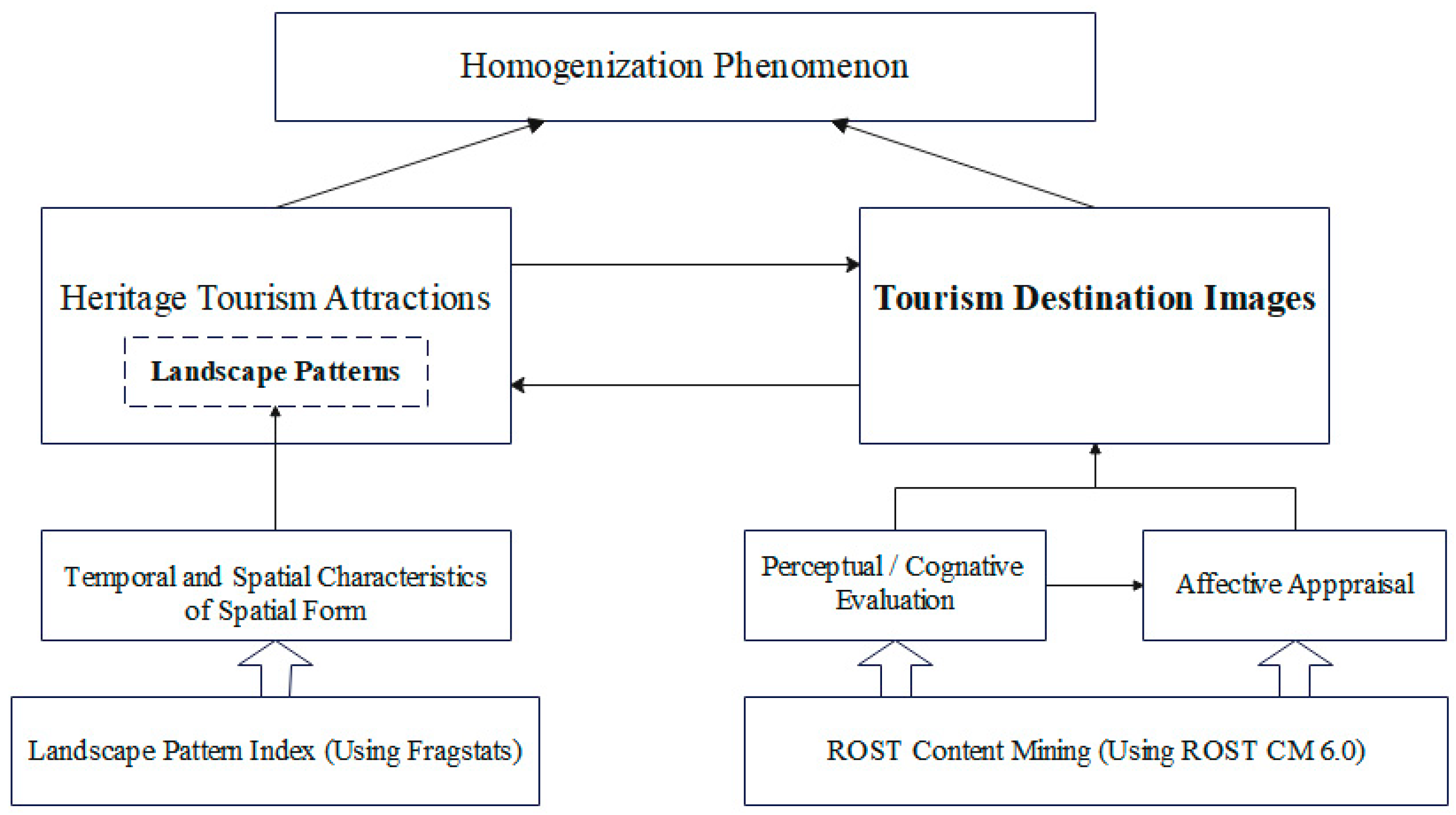


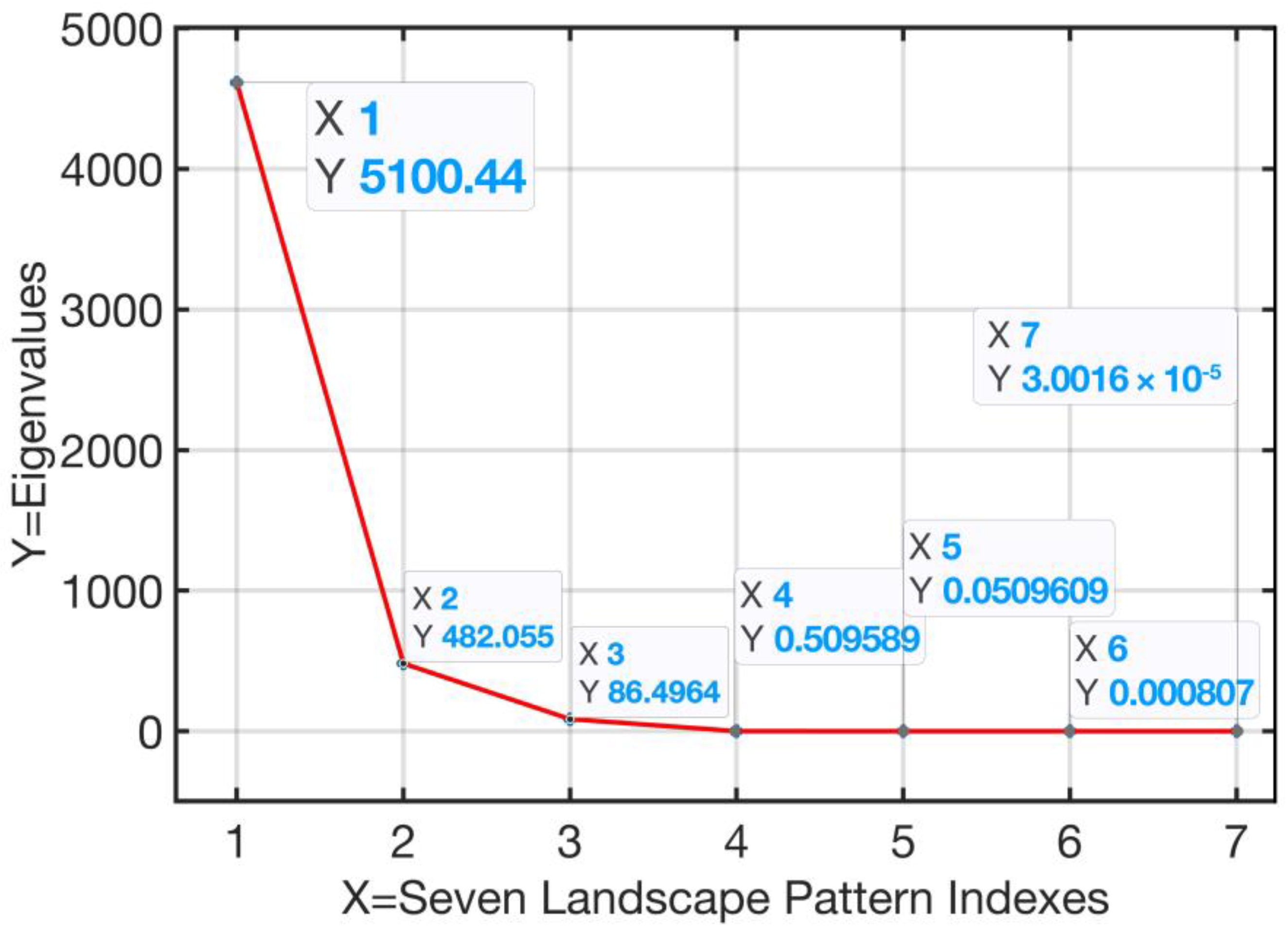
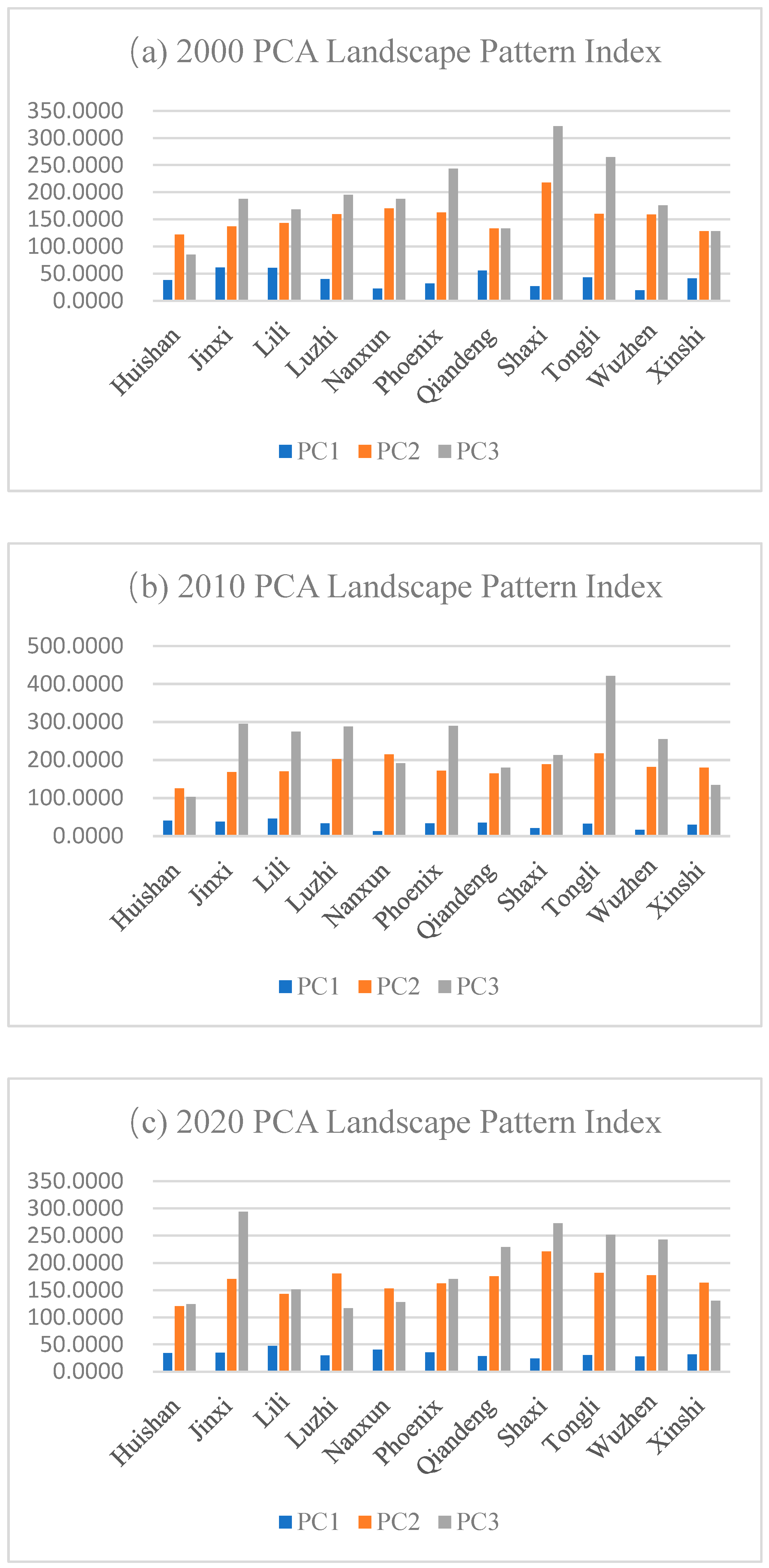

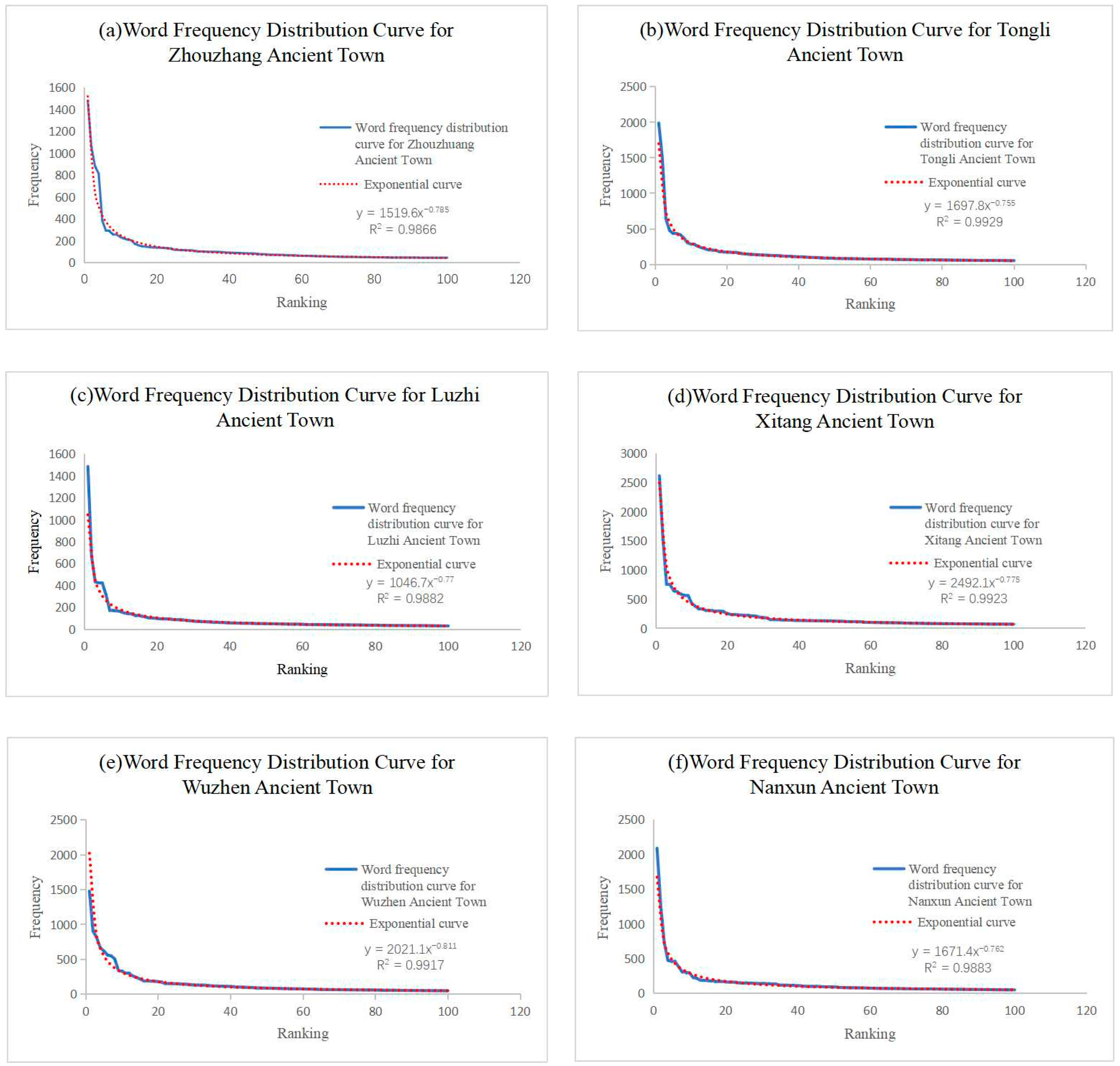
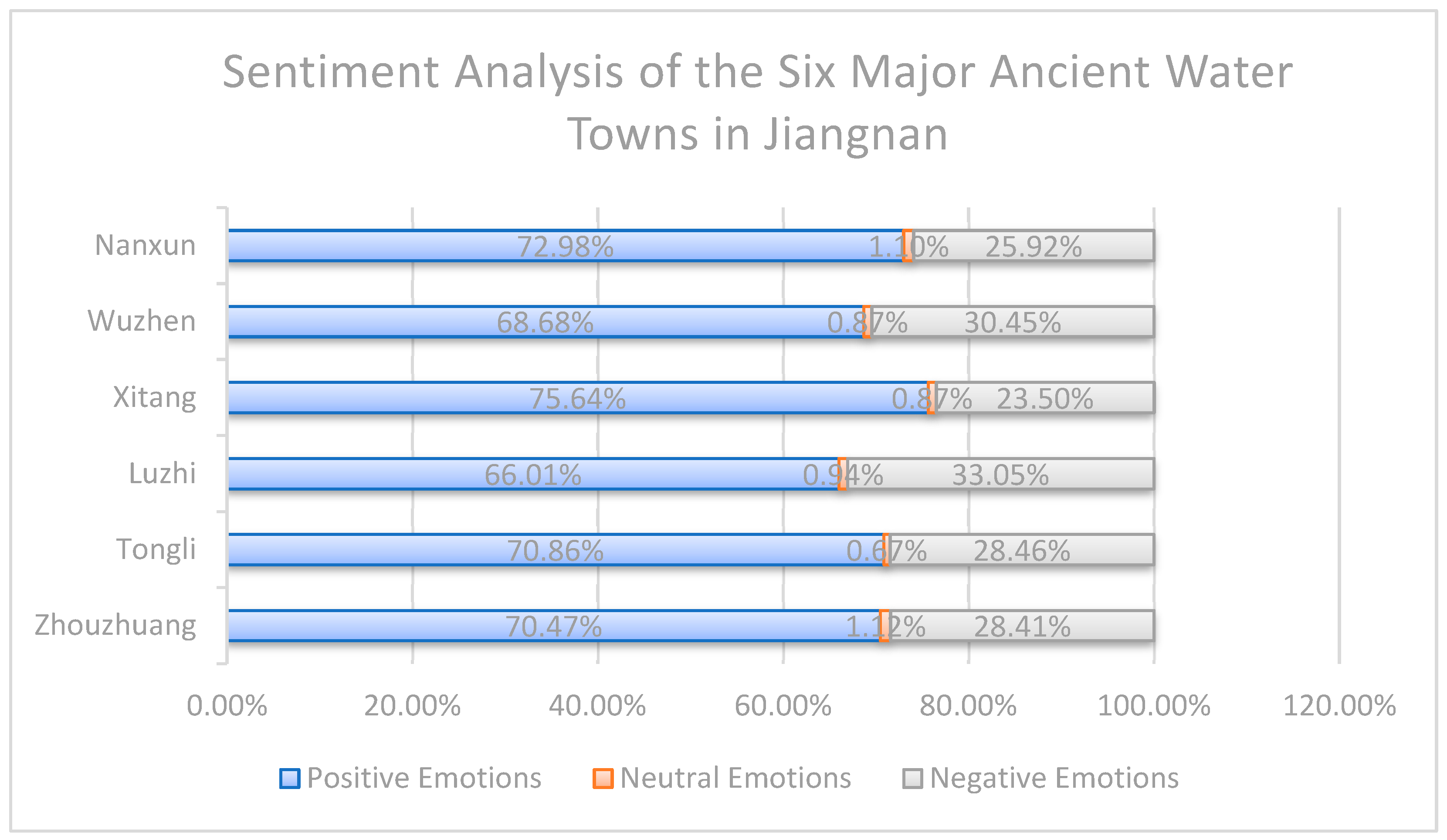
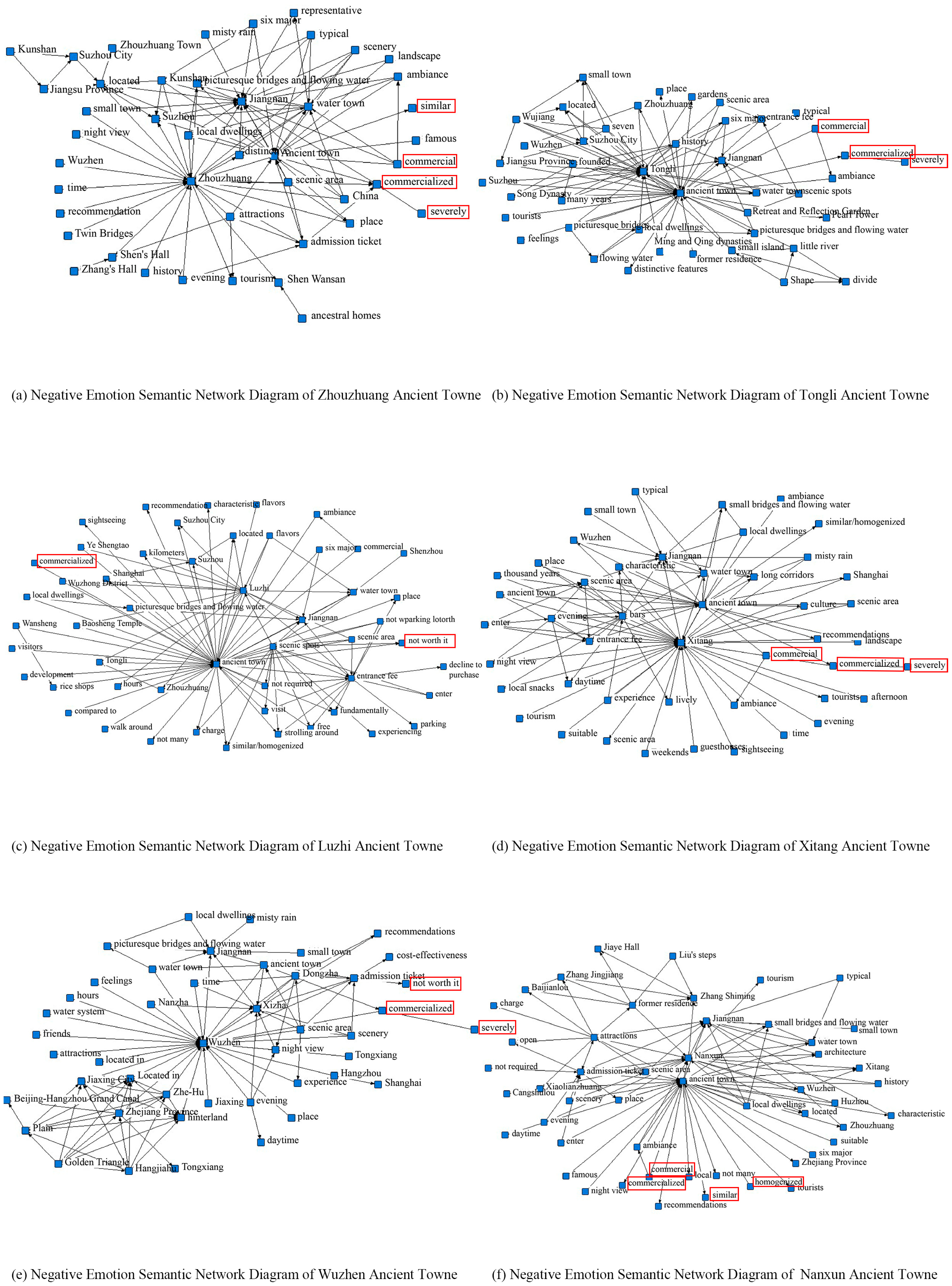
| Index (Abbreviation) | Equation | Description | |
|---|---|---|---|
| 1 | Patch Density (PD) | ||
| 2 | Mean Patch Size (MPS) | ||
| 3 | Edge Density (ED) | ||
| 4 | Patch Cohesion Index (COHESION) | ||
| 5 | Mean Shape Index (MSI) | ||
| 6 | Fractal Dimension (FRAC) | ||
| 7 | Euclidean Nearest-Neighbor Distance (ENN) |
| ED | MSI | FRAC | PD | MPS | COHESION | ENN | |
|---|---|---|---|---|---|---|---|
| Huishan | 35.7075 | 1.5622 | 1.0750 | 5.4870 | 18.225 | 98.2282 | 84.7895 |
| Jinxi | 58.5994 | 1.7054 | 1.0581 | 2.8763 | 34.7675 | 99.1959 | 187.6722 |
| Lili | 57.7301 | 1.7200 | 1.0811 | 2.4094 | 41.5047 | 99.3657 | 168.4556 |
| Luzhi | 36.9015 | 1.7325 | 1.0797 | 1.7088 | 58.5217 | 99.1308 | 195.4717 |
| Nanxun | 19.7322 | 1.5903 | 1.0712 | 1.4528 | 68.8316 | 99.5771 | 187.8192 |
| Phoenix | 28.9517 | 1.6840 | 1.0804 | 1.6337 | 61.2091 | 99.6943 | 243.4317 |
| Qiandeng | 52.8447 | 1.6080 | 1.0738 | 3.2893 | 30.4016 | 99.4293 | 133.4520 |
| Shaxi | 24.0285 | 1.8676 | 1.0811 | 0.8556 | 116.8838 | 99.7667 | 321.8509 |
| Tongli | 40.2981 | 1.7647 | 1.0830 | 1.6824 | 59.4391 | 99.0595 | 264.6637 |
| Wuzhen | 16.8490 | 1.4575 | 1.0705 | 1.7476 | 57.22 | 99.6956 | 175.8632 |
| Xinshi | 38.9015 | 1.4808 | 1.0635 | 4.0108 | 24.9324 | 99.0558 | 127.9611 |
| ED | MSI | FRAC | PD | MPS | COHESION | ENN | |
|---|---|---|---|---|---|---|---|
| Huishan | 31.7189 | 1.5114 | 1.0705 | 5.9090 | 16.9232 | 97.7684 | 123.8856 |
| Jinxi | 31.9676 | 1.5617 | 1.0725 | 1.4381 | 69.5349 | 99.4520 | 293.6478 |
| Lili | 44.5551 | 1.5744 | 1.0711 | 2.4015 | 41.641 | 99.1587 | 150.8943 |
| Luzhi | 26.9328 | 1.6262 | 1.0742 | 1.2443 | 80.3643 | 99.0638 | 116.7771 |
| Nanxun | 37.7720 | 1.6554 | 1.0779 | 1.9276 | 51.8767 | 99.3420 | 128.1655 |
| Phoenix | 32.7502 | 1.6926 | 1.0794 | 1.6337 | 61.2091 | 99.2504 | 170.2466 |
| Qiandeng | 25.9042 | 1.6583 | 1.0746 | 1.3335 | 74.9906 | 99.0637 | 228.9746 |
| Shaxi | 21.4852 | 1.7478 | 1.0797 | 0.8322 | 120.1609 | 99.3933 | 272.4550 |
| Tongli | 27.3913 | 1.6129 | 1.0689 | 1.2274 | 81.4725 | 99.1524 | 251.5134 |
| Wuzhen | 25.1705 | 1.7201 | 1.0774 | 1.2995 | 76.951 | 99.3030 | 242.2103 |
| Xinshi | 28.3830 | 1.7466 | 1.0866 | 1.5778 | 63.3779 | 98.7897 | 130.1446 |
| ED | MSI | FRAC | PD | MPS | COHESION | ENN | |
|---|---|---|---|---|---|---|---|
| Huishan | 37.9234 | 1.7788 | 1.0889 | 4.4318 | 22.5643 | 97.7081 | 102.4312 |
| Jinxi | 35.5302 | 1.6435 | 1.0852 | 1.4804 | 67.5482 | 99.1004 | 295.3427 |
| Lili | 43.2999 | 1.7836 | 1.0839 | 1.4551 | 68.7246 | 99.3567 | 274.1051 |
| Luzhi | 30.4686 | 1.8023 | 1.0834 | 0.9814 | 101.8904 | 99.2988 | 287.7509 |
| Nanxun | 9.9841 | 1.4877 | 1.0709 | 0.8788 | 113.7941 | 99.7838 | 191.3846 |
| Phoenix | 30.5293 | 1.7609 | 1.0797 | 1.4040 | 71.2252 | 99.3452 | 289.3081 |
| Qiandeng | 32.6251 | 1.6590 | 1.0795 | 1.5621 | 64.0163 | 98.9877 | 179.8091 |
| Shaxi | 18.2442 | 1.5631 | 1.0759 | 1.1433 | 87.4641 | 99.7310 | 212.8312 |
| Tongli | 29.5245 | 1.8617 | 1.0841 | 0.8571 | 116.6767 | 99.2405 | 420.9814 |
| Wuzhen | 13.8557 | 1.3551 | 1.0561 | 1.2398 | 80.6595 | 99.7490 | 254.3575 |
| Xinshi | 27.2954 | 1.8644 | 1.0936 | 1.2526 | 79.8317 | 98.7848 | 133.6438 |
| PC2 | Plow | Grass | Shrubland | Wetland | Water | Hand-Made Surface |
|---|---|---|---|---|---|---|
| Phoenix Ancient Town | 101.8 | 45.855 | 98.301 | 100.502 | ||
| Nanxun Ancient Town | 101.817 | 99.909 | 100.839 | |||
| Tongli Ancient Town | 101.422 | 99.024 | 99.716 | |||
| Xinchang Ancient Town | 101.413 | 99.252 | 100.231 | |||
| Xinshi Ancient Town | 101.952 | 102.059 | 99.53 | |||
| Xitang Ancient Town | 101.838 | 86.26 | 98.87 | 95.515 | 101.335 | |
| Qiandeng Ancient Town | 101.457 | 48.429 | 98.859 | 101.32 | ||
| Wu Ancient Town | 102.029 | 96.909 | 99.733 | |||
| Zhenze Ancient Town | 101.724 | 84.456 | 99.19 | 100.926 |
| High-Frequency Words of Zhouzhuang Ancient Town | Ranking | High-Frequency Words of Tongli Ancient Town | Ranking | High-Frequency Words of Luzhi Ancient Town | Ranking | High-Frequency Words of Xitang Ancient Town | Ranking | High-Frequency Words of Wuzhen Ancient Town | Ranking | High-Frequency Words of Nanxun Ancient Town | Ranking |
|---|---|---|---|---|---|---|---|---|---|---|---|
| Zhouzhuang | 1 | ancient town | 1 | ancient town | 1 | Xitang | 1 | Wuzhen | 1 | ancient town | 1 |
| ancient town | 2 | Tongli | 2 | Luzhi | 2 | ancient town | 2 | Xizha | 2 | Nanxun | 2 |
| Jiangnan | 3 | Jiangnan | 3 | attractions | 3 | water town | 3 | Jiangnan | 3 | Jiangnan | 3 |
| water town | 4 | attractions | 4 | Jiangnan | 4 | Jiangnan | 4 | ancient town | 4 | scenic area | 4 |
| scenery | 5 | scenery | 5 | entrance fee | 5 | scenic area | 5 | water town | 5 | attractions | 5 |
| picturesque bridges and flowing water | 6 | water town | 6 | water town | 6 | bars | 6 | scenic area | 6 | scenery | 6 |
| place | 7 | entrance fee | 7 | place | 7 | local cuisine | 7 | Dongzha | 7 | entrance fee | 7 |
| scenic area | 8 | Retreat and Reflection Garden | 8 | scenic area | 8 | scenery | 8 | scenery | 8 | worth | 8 |
| evening | 9 | scenic area | 9 | history | 9 | evening | 9 | place | 9 | water town | 9 |
| worth | 10 | Suzhou | 10 | Suzhou | 10 | place | 10 | night view | 10 | place | 10 |
| commercialized | 26 | commercialized | 30 | commercialized | 28 | commercialized | 48 | commercialized | 29 | commercialized | 29 |
| similar/homogenized | 84 | similar/homogenized | 89 | similar/homogenized | 89 | similar/homogenized | 82 | similar/homogenized | —— | similar/homogenized | 100 |
Disclaimer/Publisher’s Note: The statements, opinions and data contained in all publications are solely those of the individual author(s) and contributor(s) and not of MDPI and/or the editor(s). MDPI and/or the editor(s) disclaim responsibility for any injury to people or property resulting from any ideas, methods, instructions or products referred to in the content. |
© 2023 by the authors. Licensee MDPI, Basel, Switzerland. This article is an open access article distributed under the terms and conditions of the Creative Commons Attribution (CC BY) license (https://creativecommons.org/licenses/by/4.0/).
Share and Cite
Chen, X.; Yin, Y.; Jiang, M.; Lin, H. Deep Analysis of the Homogenization Phenomenon of the Ancient Water Towns in Jiangnan: A Dual Perspective on Landscape Patterns and Tourism Destination Images. Sustainability 2023, 15, 12595. https://doi.org/10.3390/su151612595
Chen X, Yin Y, Jiang M, Lin H. Deep Analysis of the Homogenization Phenomenon of the Ancient Water Towns in Jiangnan: A Dual Perspective on Landscape Patterns and Tourism Destination Images. Sustainability. 2023; 15(16):12595. https://doi.org/10.3390/su151612595
Chicago/Turabian StyleChen, Xue, Yue Yin, Mu Jiang, and Hong Lin. 2023. "Deep Analysis of the Homogenization Phenomenon of the Ancient Water Towns in Jiangnan: A Dual Perspective on Landscape Patterns and Tourism Destination Images" Sustainability 15, no. 16: 12595. https://doi.org/10.3390/su151612595
APA StyleChen, X., Yin, Y., Jiang, M., & Lin, H. (2023). Deep Analysis of the Homogenization Phenomenon of the Ancient Water Towns in Jiangnan: A Dual Perspective on Landscape Patterns and Tourism Destination Images. Sustainability, 15(16), 12595. https://doi.org/10.3390/su151612595





